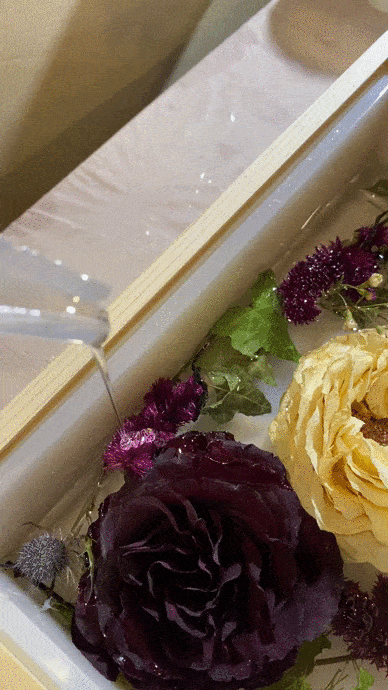The Process
The Preservation Process
Once I receive your flowers, I immediately trim stems and rehydrate them with a special formula intended for cut flowers. Once they have absorbed enough of the nutrients to firm up the stems and lift the petals, I remove them from the mixture and begin the drying process.
Flowers are cut and arranged carefully in a professional grade drying agent, taking care to slowly pour the drying agent between each petal to maintain a natural shape.
Once complete, the flowers are sealed in an airtight container for anywhere from three days up to three weeks depending on the type of flower contained within.
Finally, once the flowers have dried, they are very carefully removed from the drying agent using a combination of tools such as sifters, soft paint brushes, and forceps. Most flowers, especially red roses, will dry darker than their original appearance; however, they will lighten a shade or two again once cast in the resin.
Staging
Once the flowers have been dried, they are ready to be arranged within the mold of the client’s choice. When clients hire me, they are doing so because they have reviewed my portfolio and vibe with my design aesthetics. While I do not offer layout previews, my clients design aesthetic is taken into account via a questionnaire I send prior to permanently casting their flowers. Those that wish to be involved in the approval or modification of the final design may do so for an additional fee.
Why don’t I offer layout previews?
The short answer is that it sucks the joy out of the creation process for me.
The long answer is that I believe when a client hires an artist of any type to create a custom piece for them, they are commissioning that artist because they like the aesthetic of the artist’s previously showcased pieces. Unfortunately, more often than not when a client chooses to be involved in the nitty gritty of the design process, they unknowingly begin to micromanage the artist. Flowers are in their most delicate and paper thin state after being preserved, and certain positions or constant rearranging will not realistically be possible without damaging them. Many flowers are arranged so that they are holding up another, or placed so as to disguise a damaged petal or edge. These are flowers that look alive after dying - that’s akin to some sort of sorcery! Your understanding and cooperation is appreciated immensely during this delicate process.
After numerous scenarios like the aforementioned, I made the decision to eliminate layout approvals to salvage the enjoyment I get out of creating a unique piece that reflects the answers my client gave in my questionnaire. This leads to my client being surprised by their final design just as they were on the day of their main event.
Slowly building thin layers of resin within a mold, taking care not to drown petals and compromise their natural shape.
Casting
Once the flowers have been arranged, the casting process can begin. In order to maintain as much of the natural integrity of the petals as possible, I have to pour the resin in many thin layers, allowing each layer to mostly cure for 24-48 hours between each additional layer. This process can take between 4 and 10 weeks depending on the size of the piece, the quantity of items ordered, and the processing of other simultaneous client orders.
Bouquets go through a lot of handling before they make it to you. The flowers are harvested, processed, shipped, arranged by a florist, shipped/dropped off, photographed, danced with, carried, left on a table, sit out overnight, shipped to me, received, and finally processed for drying.
Bruising
It is important that you understand that flowers can experience something we call “bruising”. Bruising happens while the flower is alive. Depending on the type of flower, you may not even know the petals are bruised. Have you ever squished a lily petal or a succulent between your thumb and forefinger? Many times, it creates a visible fingerprint. Now think of that happening with a rose or a delicate anemone, except there is no visible fingerprint, so you don’t even know it’s there! This bruising can show up once the flower is cast within the resin. It usually manifests as a more translucent spot in a petal. This is incredibly common in white roses (but can also happen in any color rose) and extra thin flowers such as anemones or lilies.
There is no way for me to prevent this. Some flowers can handle certain types of protectant sprays; but they are not absolute, nor are they appropriate for every kind or color flower.
Once the final layer has been cast, I allow the piece to harden fully for at least 72 hours. Following this time period, I will sometimes sand down the top layer and do a final flood coat over the top or I will hand sand and polish sharp edges. The piece is then photographed, packaged up, and sent out to the recipient once final payment has been received!





